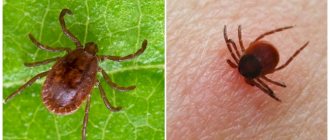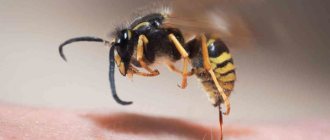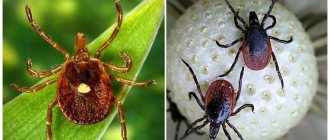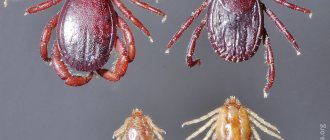The most common carriers of dangerous diseases in dogs are ixodid ticks. Canine and taiga animals carry borreliosis, babesiosis (pyroplasmosis), bartonellosis and others. There are carriers of plague, tularemia, brucellosis, Q fever and listeriosis and other diseases.
If a dog is bitten by a tick, the symptoms and consequences are not immediately apparent. The incubation period for tick-borne diseases ranges from a week to two months.
If a tick is found on a dog, the most important thing is not to panic, remove it correctly, carefully observe how the pet behaves, and if there is any suspicious change in behavior or condition, seek veterinary help. You should know that on average from 3 to 14% of the entire ixodid population are contagious.
Any modern antiparasitic medicine is extremely toxic; it kills not only the parasite, but also affects the dog’s internal organs: kidneys, liver, gastrointestinal tract (GIT), and also reduces immunity. Especially if several techniques are required. In this connection, subsequent long-term rehabilitation is necessary, which cannot be neglected. For at least 10 days it is necessary to give injections of vitamins, saline solutions, drugs to improve heart function, normalize the functioning of the liver, gall bladder, and gastrointestinal tract. At the slightest deterioration of the condition, you need to do a repeat blood test for the causative agent of the disease.
First aid for a dog after a tick bite
Owners should inspect their pet's head, neck, chest, ears and groin after each walk to detect bloodsuckers. If single individuals are found, they must be urgently removed and burned. To avoid contracting diseases dangerous to humans, do this with protective gloves. Do not crush the tick or get it into the oral cavity or mucous membranes. For multiple bites, contact your veterinarian.
If medical help is far away, give your dog 100-150 ml of water every hour. If vomiting, give an enema or subcutaneous injection. You can subcutaneously inject 20 ml of glucose solution and vitamins B6 and B12 in an ampoule daily three times a day. In case of clearly defined symptoms and lack of help, an injection of a 7% solution of Veriben or Azidine is given at the rate of 1 ml per 20 kg of dog weight.
How to take a blood test from a dog yourself: treat the ear with alcohol, cut the vessel close to the edge, collect the blood on a glass plate, dry it a little and take it to the clinic.
How to properly remove a tick from a dog?
Remove the tick with tweezers, trying to grab its body close to the skin. You need to pull the parasite slowly, holding the animal's skin with your free hand. Scrolling may cause the head of the parasite to come off, so be careful. Pet stores sell special tweezers for removing ticks.
Then you should generously treat the wound with iodine. Now all that remains is to monitor the dog daily for the next 2-3 months, and also measure the temperature. If clinical symptoms appear: lethargy, decreased activity, poor appetite, diarrhea, changes in the concentration, color and smell of urine and others mentioned above, immediately contact your veterinarian.
What diseases can ticks transmit to dogs?
Hepatozoonosis
. Caused by protozoa of the genus Hepatozoon, which infect leukocytes, spreading throughout the animal's body. This is usually due to ingestion of a parasite. Often the disease does not make itself felt for several years while the immune system is normal. When immunity decreases, fever, joint and muscle pain, weakness, and eye discharge begin. Not dangerous for people.
Ehrlichiosis
. They provoke rickettsiae - Ehrlichia. Settles in white blood cells: platelets, monocytes and granulocytes. There are rickettsiae that are dangerous to people. The disease came to Russia from Europe and the USA. A sign of all ehrlichiosis is an exhausting, growing fever.
Monocytic ehrlichiosis
: weight decreases, the animal urinates blood, the number of platelets and leukocytes decreases, weakness, hemorrhages on the cornea, mucous membranes, skin, nosebleeds, anemia, heavy breathing are observed.
Granulocytic ehrlichiosis
: high fever, weakness, cramps, inflammation of the eyelids, joint pain, enlarged liver and spleen, protein in the urine, low albumin and platelets. After 2-3 weeks, the animal’s activity decreases and lethargy appears. Sometimes it develops in a latent form and leads to severe damage to the eyes, bone marrow, joints, liver and other organs.
Bartonellosis
– red blood cells, macrophages and endothelial cells infect bacteria of the genus Bartonella.
Some Bartonella are also dangerous for people. Symptoms
: from prolonged carriage to sudden death without pronounced signs. Clinic: high fever, inflammation of the joints, drowsiness, weight loss, weakness of the hind legs, anemia, disturbances in the functioning of the heart and blood vessels, inflammation of the eyelids, nosebleeds, hemorrhages in the eyes, inflammation of the subcutaneous vessels, meningitis, pulmonary edema.
Borreliosis
(Lyme disease) is a dangerous disease for dogs and people caused by bacteria of the genus Borrelia. It is transmitted in utero and often leads to the death or non-viability of the cubs. Causes arthritis and neurological disorders. First, the joints near the bite site become inflamed. Sometimes lameness goes away on its own. Hosts become infected with borreliosis by crushing a tick. The consequences of the disease are neurological disorders, chronic inflammation of joints, blood vessels, internal organs, etc.
Babesiosis
(
pyroplasmosis
) is the most common disease for dogs.
Not dangerous for people. Caused by different types of Babesia. Symptoms
: lethargy after a bite, jaundice, fever, shortness of breath, gastrointestinal disorders, disorders in the liver, heart, lungs, kidneys and other organs. Dark: Brownish or red urine indicates kidney failure. The animal refuses food and drinks a lot of water.
Blood Hunters
Ticks are carriers of pathogenic microorganisms and bacteria that infect domestic animals and their owners. Their attacks are effective because the body, touch, and smell of the insect are aimed at searching for the victim.
The first pair of legs is equipped with complex Haller organs that recognize thousands of odors, including sweat, pheromones (products of external secretion) of a dog or carbon dioxide exhaled by it. Ticks respond to vibration, shade from a pet, and heat. Like a good hunter, they sense their prey at a distance of 20 m, remaining invisible to it at a size of 0.2 - 0.4 mm.
Most often, attacks occur in damp places of deciduous and mixed forests, parks, near paths and footpaths.
The usual place for ticks to accumulate is a copse or the border between a bush and a meadow. There, clinging to the underside of the leaves, parasites sit, waiting for a person or animal. In such corners, shade and humidity are common, and the tick is very sensitive to dry air and hides from it. That is why it is active in the morning and from 15 to 24 hours, when the heat subsides.
Dogs often pick up ticks near roadside bushes
After the attack, the tick moves along the dog's body in search of warm, moist and poorly protected places, closer to the blood vessels. Most of them are located on the neck under the muzzle, in the armpits, and groin.
Tick saliva contains anesthetic substances that inhibit blood clotting and the local immune system response.
Therefore, the tick bite is imperceptible, and it can feed on the blood of its victim for several hours or days.
The biggest threat to people and pets comes from two types of parasites:
- canine (Ixodes ricinus) - a carrier of Lyme disease, babesiosis, encephalitis, Marseilles fever and tularemia;
- meadow (Dermacentor reticulatus) - a carrier of tick-borne typhus in North Asia, Omsk hemorrhagic fever, tick-borne encephalitis, pathogens of plague, tularemia, and brucellosis.
Having drunk blood, ticks leave the animal, leaving injuries, swelling and inflammation. The most dangerous consequences of a tick bite on a dog is the penetration of toxic substances and infectious agents into the animal’s body along with its saliva. For more information about the disease, watch this video:
The most common diseases include: Lyme disease, anaplasmosis, piroplasmosis, tick-borne encephalitis.
The main thing is not to be late with treatment
Ticks are dangerous for cats and dogs as carriers of babesiosis.
Babesiosis (pyroplasmosis, babesiellosis) is an acute parasitic zoonotic infectious disease. It is caused by protozoa of the genus Babesia - Babesia Canis and Babesia gibsoni. Once in the dog's blood, they can destroy red blood cells. Clinically this manifests itself as anemia and jaundice. The infection does not bypass any breed of dogs or cats and affects animals regardless of their age.
Within a few days after the bite, symptoms of the disease appear:
- weakness;
- depression, apathy;
- lack of appetite;
- high temperature (up to 42 °C);
- problems with urination, brown urine;
- enlarged liver and spleen;
- jaundice;
- distress syndrome (respiratory failure);
- weight loss.
If treatment is delayed, the dog will experience irreversible kidney failure. Then the loss of a pet is inevitable. The effectiveness of treatment depends on a confirmed diagnosis, which is established based on the results of an analysis of the main parameters of blood morphology and biochemistry.
At an advanced stage of babesiosis, a dog cannot be saved
Treatment of pets for piroplasmosis occurs in 2 stages:
- removing parasites from the body of a sick animal;
- restoration of the normal functioning of the dog’s organs and systems.
At the first stage, antiprotozoal drugs are used. When the blood condition improves, antibiotics, antipyretics, vitamins and drugs that protect the liver and support the kidneys are prescribed.
Droppers are used to reduce the toxicity of administered drugs.
In order not to cause the dog additional suffering from the daily insertion of a needle into a vein, a catheter is inserted through which the contents of the droppers enter the blood.
The success of treatment depends on the age of the dog. Young dogs tolerate the disease more successfully. But everything depends on timely contacting a veterinarian and subsequent implementation of all his recommendations. With early diagnosis, health improvement occurs approximately 7 to 10 days after the start of treatment.
Symptoms and consequences of a tick bite in a dog
What symptoms will appear if a dog is bitten by a tick? Often the animal becomes worried because of this: it itches, shakes its head if the tick has got into the ear. What does the bite site look like? Most often, at the site of the bite, two to three hours after the parasite is removed, pronounced local redness is observed, which gradually goes away on its own. The basis of skin reaction is allergy. The severity of the symptoms depends on the type of tick, the duration of its attachment, weather conditions over the past two weeks and the state of the animal’s immunity.
The photo shows a tick bite mark on a dog.
Clinical signs are swelling, increasing radially from the center, increased skin temperature in this area, redness, itching and pain. The animal licks and scratches the bite sites. In some cases, granulomatous dermatitis begins on the second day after removing the tick.
If a lump appears at the site of the bite, this may be the result of an allergy to the parasite's saliva or infection of the wound. Hair may fall out at the site of the bump, and the dog reacts painfully to touching it.
Purulent inflammation at the site of the bite appears due to the introduction of pyogenic microbes into the open wound. Thorough antibacterial treatment and, if necessary, administration of antihistamines are required. Another reason for the bump is the head of the tick remaining in the wound. This is very dangerous - the remains of the tick begin to decompose and cause blood poisoning. See a doctor immediately - minor local surgery will be required.
Maria Smirnova
Veterinarian in a private clinic, work experience – 8 years.
It is most likely that the symptoms of the disease will appear 6-10 days after the tick attack, but it matters how the disease progresses. If the disease develops at lightning speed, you may simply not have time to take action. Fortunately, such developments do not occur often.
Pay attention to the rapid rise in body temperature to 41-42°C. This is the dog’s body’s response to the introduction of the parasite, and after a couple of days the temperature will normalize, and later it will decrease. After removing the tick, measure the temperature in the animal's anus daily. Normal temperature in dogs is 38.5°C.
Usually, the difficulty of making a diagnosis is that the symptoms of a tick bite can be different. But almost all animals refuse to eat, show drowsiness and apathy. Some of the following symptoms may appear: trembling, thirst, shortness of breath, pale mucous membranes, abdominal pain, foul odor from the mouth, blood in the urine, vaginal bleeding (in bitches), impaired motor reflexes: unsteadiness of gait, paralysis of the hind limbs (“tick paralysis”) "), dysphonia (the dog cannot bark), dysphagia (lack of swallowing), sometimes vomiting and diarrhea and some others, which we will discuss below. Signs of the disease usually increase in severity.
First aid for a tick bite - what to do at home?
The first aid you can give your dog is to remove the parasite and monitor the condition. What to do at home if, after a walk, you find a parasite that has attached itself to your dog?
First of all, determine how tightly the tick is attached. At the first stage, only the head of the parasite is immersed in the dog's skin. If the tick is on the pet for several hours, it buries not only the head, but also the paws into the skin.
To remove a tick, you need to force it to loosen its grip. Ticks breathe through their bodies, so creating a barrier that does not allow oxygen to pass through will force the parasite to remove its paws and head from the skin, freeing up space between the abdomen and the skin of the pet.
How to remove a tick from a dog?
Let's figure out how to remove a tick from a dog. To create a barrier that keeps oxygen out, you can use oil, greasy cream, nail polish or soap suds. If necessary, the fur around the parasite must be shortened.
- Apply the selected product to the tick every 5 minutes. Depending on the degree of attachment, after 10–15 minutes you will be able to move the tick with your fingers.
- The next step is to remove the parasite. To preserve the integrity of the skin, the ticks are not torn off, but rather twisted out. There is absolutely no difference in which direction you twist the tick - clockwise or counterclockwise, the main thing is that it is comfortable for you.
To remove a tick, you can use special tools, tweezers, a clamp or thread. The special tool is a small plastic hook that resembles a nail puller. The legs of the hook are placed under the tick, after which the tool is twisted and lifted.
If you don't have special tools, a clamp or tweezers with flat edges will do. It is important to grab the tick near the skin and not by the body, since pressing can crush the shell.
A relatively safe method involves using thread. A loop is placed over the tick, after which the thread is crossed and twisted. When the head of the tick is tightly covered by the thread, they begin to scroll it, slightly pulling the parasite up.
Most likely, the dog will behave calmly during all manipulations. However, at the crucial moment when the head of the tick emerges from the skin, the dog will feel a sting, which can lead to an unexpected reaction. Enlist the help of a friend or family member to hold your pet and prevent him from making sudden movements.
When the tick is removed, it must be placed in oil. It is better to close the container, since the parasites are very agile. It is safest to burn the tick after removing it from the oil. Like all parasites, ticks are capable of going into suspended animation, that is, the parasite will visually look dead, but after a few hours it will come to its senses and continue searching for victims.
Important! If you live in a disadvantaged region, do not destroy the tick under any circumstances! The parasite can be submitted to a laboratory, where tests will be carried out to determine whether the tick was a carrier of dangerous diseases.
What to do if the head remains in the dog’s body
What to do if the tick head remains in the body? In fact, you will not be able to take any urgent measures. The tick head that remains under the dog’s skin is a foreign protein that the body will fight against. If your pet is healthy, the tick's head will encapsulate and come out along with pus or other body fluids.
Swelling and inflammation will most likely develop at the site of the bite. Your task is to monitor the dynamics and general condition of the pet. If your dog has a fever or other alarming symptoms, it should be taken to the veterinarian.
To stop the inflammatory process, the affected area of the skin is opened and cleaned. In most cases, the inflammation is eliminated by forming a fistula, through which odorless white pus comes out.
What to do if the dog is pregnant
Do not wait for the first symptoms and development of the clinical picture after a tick bite if the dog is pregnant. Take your pet to the veterinarian immediately and explain the situation to the doctor. With any type of blood poisoning, puppies are the first to suffer. Depending on the stage of development, embryos may become more active or, conversely, freeze.
Treating a pregnant dog always carries the risk of abnormal embryo development. With toxic treatment, a dog may have a miscarriage, which, despite all the tragedy, is considered a favorable outcome.
Signs and symptoms of piroplasmosis
The single-celled protozoan piroplasma (Piroplasma canis) destroys red blood cells. A blood test shows a sharp decrease in the number of red blood cells. Toxic breakdown products of hemoglobin accumulate in the body, which disrupts the functioning of internal organs. How many days does a dog get sick after being bitten? The answer to this question depends on the initial condition of the animal, but usually the incubation period is 4 – 15 days. Its duration depends on the number of parasites in the blood, the time of blood sucking and the immunity of the victim. If detected early, piroplasmosis responds well to treatment, but long-term rehabilitation is required.
The dog's condition may deteriorate sharply. With an extremely rapid course, the animal dies without obvious signs of disease.
In the acute form, the following symptoms appear: changes in behavior, weakness, lethargy, loss of interest in what is happening, fever up to 42°C, refusal to walk, darkening of urine, pale or yellow mucous membranes, shortness of breath, paralysis of the limbs occurs. Death on 3–7 days from the moment of infection. With timely treatment, the dog's chances of survival are quite high.
With chronic piroplasmosis, all symptoms are blurred, only fatigue and weakness are expressed. In the latent form, symptoms do not appear.
Immune system failure
The symptoms of these diseases in the early stages resemble a cold. The lack of specific manifestations makes their rapid diagnosis difficult.
They can live without oxygen, do not have a cell wall, and are therefore resistant to antibiotics. These bacterial parasites are transmitted by ticks, mosquitoes and other biting insects. Infection can also occur through contact between an infected mother dog and a puppy.
Often the disease leads to the need to remove the spleen, which is a hematopoietic organ.
Usually the disease overcomes animals weakened by other pathologies. It is especially difficult in dogs with splenectomy (removal of the spleen). This organ is a kind of filter that cleanses the blood of red blood cells damaged by parasites. When it is removed, the immune system, affected by mycoplasma, mistakenly recognizes its own red blood cells as foreign and destroys them.
The cause of the disease can be determined using a blood test. Polymerase chain reaction (PCR) is also used - a highly accurate method of molecular genetic diagnostics. Treat the infection for at least 3 weeks with antibiotics (tetracyclines), continuing symptomatic therapy.
Canine hepatozoonosis is caused by protozoa of the genus Hepatozoon, which attack bones, liver, and myocardial capillaries. Infection occurs mainly due to the back injection of already infected blood when an attempt is made to remove the tick from the dog’s body. For more information about what to do after a tick bite, watch this video:
Symptoms are similar to other infections after bites - fever, loss of appetite, neurological phenomena. There are all the signs of anemia, accompanied by characteristic leukocytosis. But bloody diarrhea, swollen lymph nodes, hyperacusis of the skin (pigmentation disorder), dull coat - these are already specific symptoms inherent in this disease. Upon autopsy of a dead animal, necrosis of the spleen, atrophy of the red and yellow bone marrow, and inflammatory infiltrates in organs and muscles are obvious.
There is still no effective treatment for the disease.
Severe clinical forms cannot be treated. Anti-inflammatory drugs may not be effective in treating movement disorders.
If prescribed in a timely manner, imidocarb or other antibiotics of this series may help.
Another complication after a tick is purulent inflammation of the skin at the bite sites caused by animals scratching the wounds.
December and February are also marked by cases of tick-borne diseases, although the greatest risk for pets occurs in the spring and fall. This means that your beloved creature must be protected at all times.
How is piroplasmosis treated in dogs?
The sooner treatment for piroplasmosis begins, the higher the animal’s chance of survival. Recovery will last 4–5 weeks at best.
For proper treatment, it is important to exclude similar ailments: liver damage, poisoning, leptospirosis, glomerulonephritis, plague.
It is urgent to do blood and urine tests. A blood test will help quickly identify babesiosis by the many destroyed red blood cells and piroplasms in them. Hemoglobin in the urine of a sick dog confirms the diagnosis.
Stage-by-stage treatment:
- Antiparasitic drugs: Veriben, Berenil, Azidine (diminazine) - less toxic. Stronger: Imidocarb, Imizol, Piro-stop.
- Alkalization of urine for normal kidney function. Sodium bicarbonate is injected intravenously to prevent blockage of the renal tubules by hemoglobin crystals. The animal is also given a solution - 2 g of soda per 10 kg of body weight until the hemoglobin is completely removed from the urine. Instead of soda, you can give the drug blemaren - 1 tablet per 10 kg of weight per day.
- Vitamins, diuretics, glucose, tonic, hemostatic.
- Purification of blood by transfusion or filtering.
- A recovered dog should be limited in movement for 10-15 days. Special care and diet will be required.
After the disease, unstable immunity lasts 4-6 months. Afterwards, there is a risk of becoming infected with piroplasmosis again.
Symptoms of encephalitis in dogs
Of course, encephalitis is primarily dangerous for humans, but if the immune system is weakened, the dog can also get sick. The bite of an encephalitis tick causes severe symptoms. The incubation period is about 2-3 weeks. Typically, there is an increase in temperature, convulsions, impaired motor functions, and paralysis. A characteristic symptom is hypersensitivity of the head and neck, severe pain. A change in mood may occur - apathy or aggression, and later - paralysis of the facial and eye muscles. There is obvious brain damage, and since there is no specific treatment for encephalitis for dogs, the prognosis is unfavorable: almost one hundred percent death. Symptoms may go away after the first deterioration, but this is not a cure, but a sign of a suppressed immune response. The encephalitis tick has no special signs.
Diseases transmitted by tick bites
Every owner should research diseases transmitted by tick bites. There are three deadly diseases transmitted by pasture ticks. For each disease there is a specific treatment that will be effective if started on time.
Remember! If a dog becomes infected after a tick bite, the main problem may not be blood poisoning, but its consequences.
Piroplasmosis
The most common disease transmitted by ticks is piroplasmosis. The disease is characterized by blood damage, which leads to the rapid development of the clinical picture and death of the dog.
A particular danger is that ticks that carry piroplasmosis are actually healthy, can survive the winter and produce already infected offspring.
Symptoms of piroplasmosis:
- Loss of strength, weakness in the hind legs, apathy, reluctance to move.
- Very poor appetite or complete absence of it.
- At the first stage there is an increase, and after that, a decrease in base body temperature.
- Pallor, and then yellowness of the mucous membranes of the gums.
- Lack of shine, and then yellowness of the sclera of the eyes.
- Urine the color of dark beer.
A potentially healthy dog infected with piroplasmosis, in the absence of treatment and emergency care, will live no more than 3 days. The more advanced the stage of development of the disease, the more complex therapy will be required to restore the body.
Important! If help is not given in a timely manner, irreversible changes can occur in the dog’s body.
Consequences of a tick bite that carries piroplasmosis
Piroplasmosis is not as dangerous due to blood poisoning as its consequences. The dog dies due to liver failure, as enemy microorganisms constantly accumulate in its blood. Even if help was provided to the dog on time, after recovery directly from piroplasmosis, restorative therapy is carried out.
As a restorative therapy, the dog is required to be prescribed hepatoprotectors, immunostimulants and broad-spectrum antibiotics if there is a risk of an inflammatory process.
The recovery course can last from 3 to 21 days, depending on the degree of liver damage. Monitoring of the body’s recovery is carried out constantly; at a minimum, you need to do two ultrasound examinations of the liver and monitor the functioning of the dog’s gastrointestinal tract.
Lyme disease
Lyme disease is bacterial in nature and can affect not only dogs, but also people. Infection occurs during a bite when the tick injects saliva into the dog's bloodstream. The difficulty is that Lyme disease can occur in adult dogs completely asymptomatically, until the body’s immune defense is weakened. When a dog's health is compromised, it can catch a simple cold, which is complicated by a bacterial blood disease.
Symptoms of Lyme disease include:
- Persistent fever.
- Complete loss of appetite.
- Apathy.
- Loss of strength, which periodically goes away on its own.
- Wandering pain syndrome.
- Swelling of the joints.
Lyme disease has a complex development cycle. The bacteria parasitize at least two intermediate hosts before infecting a warm-blooded animal or person. Unfortunately, Lyme disease is rarely diagnosed on time, so its latent course leads to irreversible changes in the dog’s body.
Important! Lyme disease is one of the ailments that causes chronic diseases of the musculoskeletal, lymphatic and excretory systems.
Consequences of Lyme disease
Lyme disease that occurs silently or ignores the symptoms of bacterial blood poisoning leads to kidney failure. Unfortunately, in most cases, the disease cannot be cured at this stage, and it leads to the death of the dog.
At an intermediate stage of development, if Lyme disease progresses silently, it can cause symptoms of heart failure and central nervous system dysfunction.
To detect the disease in time, laboratory diagnostics is necessary. The slightest swelling of the joints after a tick bite should be the reason for a comprehensive laboratory examination.
Encephalitis in dogs
Tick-borne encephalitis of dogs is a viral disease of the central nervous system, which is transmitted through the bites of pasture ticks. The diagnosis must be considered as a general term covering at least three direct diseases caused by three different parasites.
The incubation period of tick-borne encephalitis ranges from 7 to 14 days.
Symptoms of the disease are:
- Fever.
- Severe disturbances in the functioning of the central nervous system - absence of the respiratory and swallowing reflex, loss of coordination, impaired reflexes, trembling, convulsions, paresis, paralysis, etc.
Because neurological symptoms may indicate other brain-related diseases, tick-borne encephalitis can only be confirmed by laboratory methods. Unfortunately, searching for antibodies in an animal's blood is not an effective test and often gives a false negative result. The only effective diagnostic method is a laboratory blood test using the PCR method.
Consequences of an encephalitis tick bite
The consequences of an encephalitis tick bite are unpredictable, but disappointing in all forecasts. Even with timely diagnosis, effective treatment and rapid recovery, it is likely that your dog will continue to have some neurological symptoms. Recovered dogs often exhibit tics, seizures, impaired reflexes, or changes in personality.
Important! Most dogs that become infected with tick-borne encephalitis die before diagnosis.
Without laboratory PCR analysis, a veterinarian can assume more than a dozen diagnoses that are associated with inflammation affecting the dog’s brain function. Almost all inflammations are treated with antibiotics, which are not effective against tick-borne encephalitis (virus).











